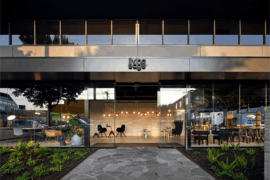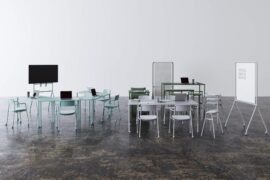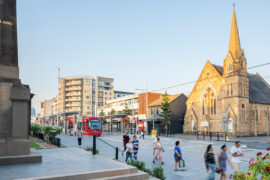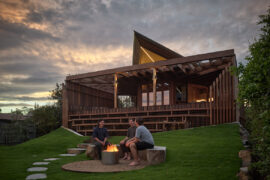In honour of International Women’s Day, Indesign takes a look at just a small handful of women who can easily be described as game changers.
March 7th, 2018
Having grown in momentum over the last few years, International Women’s Day is not only a day of recognition for the ‘fairer’ sex but speaks of a much wider socio-political movement.
But how does this fit within an Australian design context? The debate around gender equity in the architecture and design industry has gone from strength-to-strength, with many thanks due to initiatives like the Australian Institute of Architects’ Gender Equity Committee and Parlour.
What do some of the industry’s leading ladies have to say about where they are now, how they’ve seen the field change and the advice they’d give their younger selves? That is exactly what we find out.
It goes without saying; this list is by no means exhaustive (Marion’s List by Parlour is a better resource for that), but this selection of women in design, from varying stages and ages, showcases how they are each setting their own course in a tough industry.
Sue Fenton is a Senior Associate at Woods Bagot. Sue works across many design disciplines at the international practice including workplace and education.
When asked what advice she would give to young women coming up in the industry today, Sue says, “While it’s so easy to get consumed by our day to day work as designers, it’s critical to make the space where your ideas are unencumbered from all the usual parameters (even if some of these remain process only).
“When you embark on these personal projects or investigations of ideas you are continually building on your design methodology. Connecting with strong women mentors and advocates provides the courage and support to say ‘Yes’ to opportunities that seem outside your capability. Sometimes we forget what we know.
“Leaping into the unknown and embracing new projects builds personal practice as a creative thinker, it also surrounds you with like-minded people and develops rich collaborations with diverse disciplines. The challenge is to continually evolve and grow.”
–

Manuela Millan is an interior designer at Elenberg Fraser and the founder of blog Meanwhile in Melbourne.
Manuela Millan is not only an interior designer at Elenberg Fraser but also the founder of Meanwhile in Melbourne – a blog that showcases the creative design talent from across the city.
As someone still establishing herself in a design career, we asked how gender equity affects Manuela, if at all.
“I am very lucky that I haven’t experienced any gender inequality first-hand in my career so far, and I’ve never felt that being a woman has negatively affected my work opportunities.
“I am grateful to the strong women who have come before me and who have set the example of how to crush it as a woman in design. I think that it’s important for women to feel empowered to speak out whenever we encounter discrimination or sexism in this industry, and to support and listen to women who are brave enough to share their experiences.”
–
Rachel Nolan is the Co-founder of the highly-awarded practice Kennedy Nolan and has built a strong reputation for outstanding residential work over a long career.
Reflecting on the industry and how it’s changed, Rachel shares, “Together with my business partner Patrick Kennedy, we have run our practice together, and quite unintentionally we have always been a studio with more female architects than male architects.
“Currently, we are the closest we have ever been to achieving gender equity: with 13 women and eight men…. but I am guessing the equity question doesn’t exactly apply when the numbers sit in favour of women! Our industry has changed. Gender equity is taken seriously.
“Women are well represented on our boards, in our awards juries and at our Institute. There is a great wave of camaraderie that currently exists in our profession and I think that comes from broad representation and a deep desire for us all to work together to promote good architecture.”
Rachel also talks about the pressures of being a female architect, “Years ago when my kids were very little, the pressure of being the primary carer and a working architect was tough. This is common.
“There have been 16 children born to women working in our practice over the years… so we have ‘in-house’ empathy. Shared experience makes this stressful time a whole lot less stressful.
“With the youngest of my three kids nearly 10 years old, I feel like I am finally coming up for air and am able to hit my stride again.”
–
Kirsten Stanisich is the Director of Interior Design at SJB Sydney. Having recently taken out Designer of the Year at IDEA, Kirsten’s work is turning heads and cementing her outstanding talent.
When asked if the industry is catching up with gender equity, Kirsten shares, “I think the industry has just come to terms with understanding that there is an issue around gender equity, particularly at the senior and partnership levels of large architectural practices.
“There is still a long way to go, but I am very positive about seeing the momentum increase and I am hoping that when I eventually leave this profession it will be a very different place to where I started.”
On advice to young women starting out, Kirsten says “My advice to young women entering the industry is to keep up your endurance, because all of the small changes happening right now, will suddenly result in major change across the industry.”
–
Emma Williamson is a Director at Cox Architecture Perth, having been the Co-founder of CODA Studio with Kieran Wong and steering the successful practice into a successful merger.
Emma’s advice to young women coming up in the industry is practical and to the point, “The first thing I would advise a woman in architecture is – get registered before you start a family! This is a huge confidence booster; it positions you well for re-entry into the profession after a break and will have the effect of getting you on site early. You should choose your employer on the basis of this opportunity.”
In terms of initiatives that have helped to create gender equity, Emma shares, “Women have started to find their voice through the collective efforts of projects such as Parlour.
“I think that we can also see that it makes financial sense to capitalise on our investment in the education of men and women and to work on ways of retaining talent.
“It is through the conscious actions and support from men in the workplace that we can see real change. More women have a seat at the table now and I think this will have a huge, positive impact in the coming years.”
–
Get more stories like this straight to your inbox. Sign up for our newsletter.
INDESIGN is on instagram
Follow @indesignlive
A searchable and comprehensive guide for specifying leading products and their suppliers
Keep up to date with the latest and greatest from our industry BFF's!

For Aidan Mawhinney, the secret ingredient to Living Edge’s success “comes down to people, product and place.” As the brand celebrates a significant 25-year milestone, it’s that commitment to authentic, sustainable design – and the people behind it all – that continues to anchor its legacy.

Welcomed to the Australian design scene in 2024, Kokuyo is set to redefine collaboration, bringing its unique blend of colour and function to individuals and corporations, designed to be used Any Way!

Australia’s first planted light rail corridor sets new benchmark for transport-led urban transformation.

COX Architecture uses saturated colour and hotel-style amenity across the historic St Peters location, designed for Coronation Property.

Central Station by Woods Bagot in collaboration with John McAslan + Partners has been named one of two joint winners of The Building category at the INDE.Awards 2025. Recognised alongside BVN’s Sirius Redevelopment, the project redefines Sydney’s historic transport hub through a transformative design that connects heritage with the demands of a modern, growing city.
The internet never sleeps! Here's the stuff you might have missed

Humanscale’s new showroom is about the modern workplace, with ergonomic excellence, sustainable design and architectural heritage in Singapore.

Recognised as a winner at the INDE.Awards 2025, Barton Taylor has received The Photographer – Residential accolade. His photographic work on Cake House captures the soul of a coastal icon reimagined, blending light, texture and atmosphere into a compelling visual narrative.